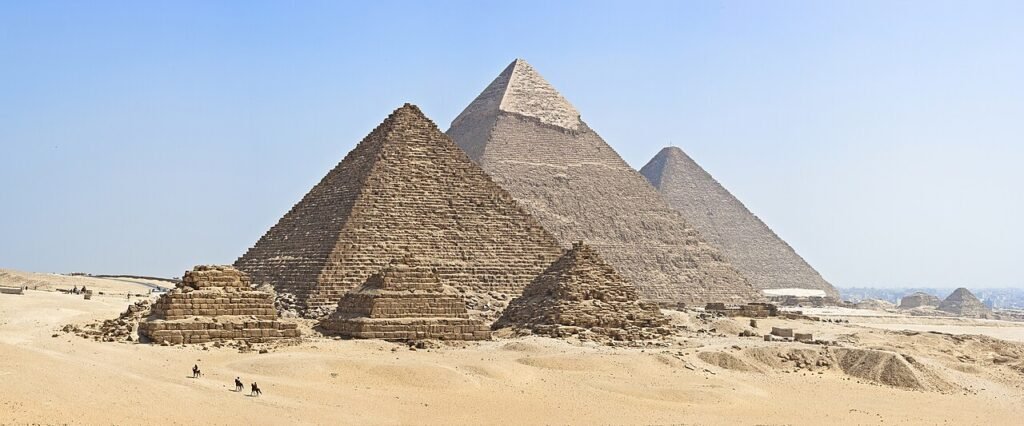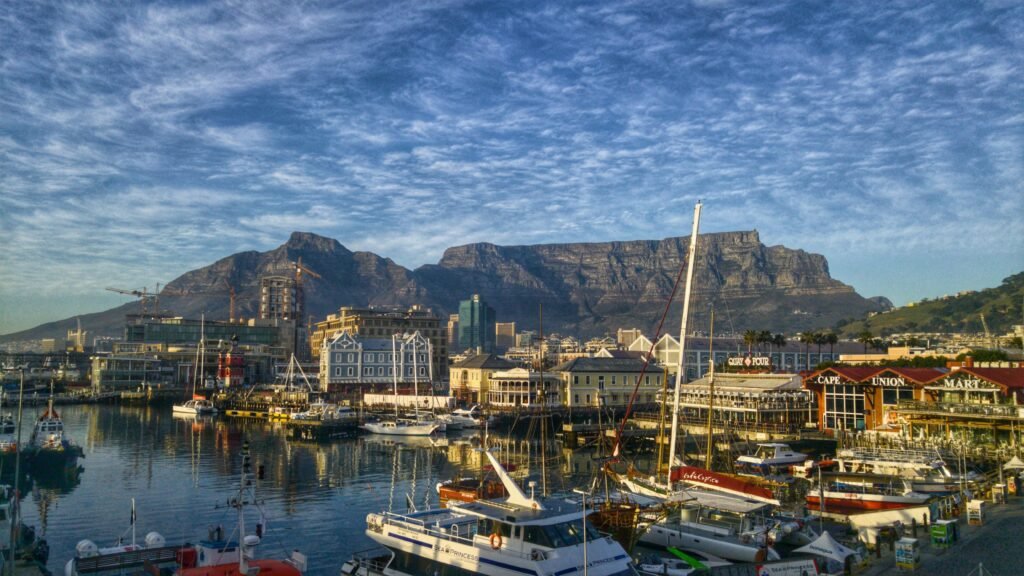
The Pyramids of Giza sit on the edge of Greater Cairo, where the city frays into desert, a line of geometry against a dun-coloured horizon. However many times you’ve seen them, the first in-person glance is disarming: limestone angles, the watchful Sphinx, and a sweep of sand that turns gold in late afternoon light. For UK travellers, families on school-holiday adventures, couples chasing a once-in-a-lifetime view, and solo culture seekers, Giza is both the headline act of a wider Egypt trip and an easy long-weekend classic from London. This guide blends essential on-the-ground advice with wider UK tie-ins so you can plan with confidence.
Pyramids of Giza: what you’re looking at (and why it matters)
Three royal pyramids define the Giza Plateau:
- Great Pyramid (Khufu/Cheops) — the largest, built c. 4,500 years ago during Egypt’s Old Kingdom (4th Dynasty).
- Pyramid of Khafre (Chephren) — slightly smaller but appears taller thanks to its higher base and surviving cap of casing stones.
- Pyramid of Menkaure — the smallest of the trio, flanked by three “queen’s pyramids”.
Together with the Great Sphinx, valley temples and extensive cemeteries, these monuments form the northern edge of the Memphis and its Necropolis UNESCO World Heritage site, which stretches south past Saqqara and Dahshur. It’s one of the world’s most important archaeological landscapes and the only surviving Ancient Wonder.
Good to know for first-timers
- Inside or outside? You can buy a general entry to roam the Giza Plateau (Sphinx, viewpoints, exteriors). Entering a pyramid is a separate ticket; the Great Pyramid is the signature experience (narrow passages, steep ramps, warm, magical air, but not for the claustrophobic).
- It’s a living site. Conservation work, new paths and a revamped visitor system (more on that below) continue to improve flow, facilities and preservation.
- Expect scale. Distances between monuments are bigger than they look; budget time for walking or the official electric buses inside the site.
What’s new on the Giza Plateau in 2025
In recent seasons, Egypt has rolled out a modernised visitor experience at Giza:
- New main entrance and visitor centre on the Fayoum Road (often signposted as the “Great Gate”), replacing the old gate by Marriott Mena House.
- Electric hop-on, hop-off buses shuttle between the visitor centre and key stops (Great Pyramid, Sphinx, panorama points, restaurants), and private vehicles and tour buses no longer drive onto the plateau.
- Online ticketing is available for general entry and selected interiors.
- Dining with views has levelled up, with on-site venues such as 9 Pyramids Lounge and Khufu’s, both designed to keep footfall within designated areas and reduce litter.
Why you’ll feel the difference: cleaner sightlines, fewer ad-hoc vendors inside the archaeological zone, and safer movement for families, especially with small children or grandparents in tow.
Practicalities at a glance
Opening hours & best times
- The plateau typically opens from 7:00, with the last entry mid-afternoon. Hours can shift slightly by season and during Ramadan; always check close to travel.
- Arrive early (gate opening) or go late (90 minutes before last entry) for softer light and thinner crowds.
- Cooler months (Oct–Apr) are more comfortable for kids and for anyone planning to go inside the pyramids.
Tickets
- General entry to the Giza Plateau is purchased online or at the visitor centre.
- Separate tickets are required to enter the Great Pyramid, Khafre or Menkaure (availability for interiors can be limited day-to-day).
- Card payments are increasingly standard; bring a small float of Egyptian pounds for tips and incidentals.
On-site transport
- Use the official electric buses (they loop every few minutes) or walk between stops if the weather allows. Distances are longer than they appear on the map; hats and refillable bottles are a must.
Facilities & rules
- Expect modern toilets, shade at the visitor hub, designated photo viewpoints, and restaurants with controlled access.
- Drones are prohibited without formal permits. Tripods may be restricted; staff directions on the day take precedence. Inside the pyramids, photography rules can vary. Assume no flash and be respectful.
Accessibility
- Surfaces on the plateau can be uneven, sandy and sloped. The new bus system reduces long walks, but wheelchair access to the interiors of pyramids is not feasible due to steep, narrow tunnels. Many families and travellers with limited mobility still find the viewpoints, Sphinx area and bus stops rewarding.
Getting there from the UK (and around Cairo)
Flights
- Direct London–Cairo services operate multiple days per week, with a flight time of around 5 hours. Cairo International (CAI) is the main gateway.
- From CAI, the transfer to Giza takes 45–90 minutes, depending on traffic. Pre-book a reputable transfer or use a ride-hail app.
Visas & entry
- Most UK visitors use Egypt’s e-Visa system (online application before travel) or visa on arrival (cash in USD at Cairo airport). Check requirements shortly before departure and ensure your passport has 6 months’ validity beyond arrival.
Getting to the plateau
- Ask your driver for the Fayoum Road visitor centre entrance. If you’re metro-savvy, Cairo Metro Line 2 runs to Giza; from there, a ride-hail to the visitor centre is straightforward.
The case for pairing Giza with Cairo’s museums
A pyramid visit is visceral; museums provide the context. In 2025, many travellers split time between:
- The Egyptian Museum (Tahrir Square) — still home to marquee pieces and a gloriously dense, old-school atmosphere.
- The Grand Egyptian Museum (GEM) — the vast new complex near Giza. Its full inauguration is targeted for late 2025. Portions may be open on a trial basis; check what’s accessible during your dates and consider a combo day with Giza if galleries you want to see are operating.
Why do both? You’ll connect the engineering you’ve just walked around with the daily life, religion and craft of the Old Kingdom, ideal for curious kids and culture-loving couples.
How to structure your time: three tried-and-tested itineraries
1) One perfect day: Giza focus (families & first-timers)
07:00–09:30 — Gate opening & Great Pyramid
Arrive for opening. Collect your plateau tickets and, if you plan to go inside, Great Pyramid interior tickets. Walk or bus to the Great Pyramid. Families: decide in advance if a pyramid interior is right; passages are steep, temperatures are warm and ceilings are low.
09:30–10:30 — Khafre & the Sphinx (Valley Temple)
Ride the bus to the Sphinx stop. Young explorers love tracing the Sphinx’s profile from different angles; parents appreciate shade pockets around the temple.
10:30–11:15 — Panorama Point
Head to the panorama stop for classic three-pyramid shots. This is where you feel the desert: wide, windy, bright.
11:30–12:45 — Lunch with a view
Pre-book 9 Pyramids Lounge or Khufu’s for Egyptian dishes and a rest with air-con nearby.
13:00–14:30 — Optional: Menkaure & queens’ pyramids
If energy allows, loop the smallest pyramid. Otherwise, save it for next time and bus back to the visitor centre.
Late afternoon — Pool time & early night
Families staying near Giza (see hotel picks below) can recharge by the pool—key for keeping small travellers happy.
Evening add-on: Sound & Light Show at the Sphinx theatre. Language-scheduled shows run most nights; book ahead and bring a layer after sundown.
2) Culture-rich 48 hours: pyramids + the city (couples & culture lovers)
Day 1 — Giza at leisure
Morning inside the Great Pyramid, then slow lunch at Khufu’s. After a siesta, return for golden-hour photography from panorama stops and book the Sound & Light Show.
Day 2 — Museums & Old Cairo
Start at Tahrir’s Egyptian Museum (or GEM if key galleries are open). After lunch, switch gears to Islamic Cairo: the Citadel, Sultan Hassan Mosque, and Khan el-Khalili lanes. Couples often cap the day on a Nile terrace with a sunset drink.
3) Three days for history completists: Giza, Saqqara & Dahshur (solo travellers & archaeology fans)
Day 1 — Giza deep dive
Do the full Giza loop, including Menkaure and a stop at the workers’ cemetery or Meresankh III if open. Explore slower, photograph details.
Day 2 — Saqqara & Memphis
Pre-book a car/driver for a Saqqara day trip (~40–60 minutes from Giza). Don’t miss the Step Pyramid of Djoser, the Imhotep Museum, and accessible tombs with gorgeous reliefs. Briefly visit Memphis (Mit Rahina) for the colossal Ramses II statue.
Day 3 — Dahshur & a museum
At Dahshur, the Bent and Red Pyramids sit in a quieter desert setting. Return to Cairo to finish with museum time (Tahrir or GEM trial areas) so the architecture and artefacts can speak to each other.
Logistics notes: for Saqqara/Dahshur, trust an experienced driver; sites can close without notice for conservation.
Family, couples, and solo: tailored advice
For families
- Pace is everything. Start at gate-open, exit before heat peaks, and book a hotel with a pool.
- Pick one interior. If you go inside, choose the Great Pyramid and plan a cool-down afterwards.
- Pack like a pro: brimmed hats, sunscreen, refillable bottles, wipes, snacks. Show kids the Sphinx story beforehand to anchor the visit.
For couples
- Golden hour matters. Aim for late-day panorama stops for soft light and fewer crowds.
- Upgrade for the view. A pyramid-view room turns a bucket-list day into a mini-moon.
- Dinner strategy: book a window or terrace table at on-site venues or at your hotel to avoid evening traffic back into town.
For solo travellers
- Guides add context. Hire a licensed Egyptologist at the visitor centre for site-specific insights.
- Stick to official routes. Politely decline persistent sales pitches and keep valuables zipped; Cairo is friendly but busy.
- Evening plan: pick accommodation with on-site dining or room service to avoid late-night cross-town treks.
Where to eat (with a view and beyond)
- 9 Pyramids Lounge (on the plateau) — Bedouin-style seating, Egyptian classics, sweeping pyramid vistas. Book mid-morning or early lunch to sidestep peak heat.
- Khufu’s (on the plateau) — A polished, contemporary Egyptian menu with floor-to-ceiling views; great for a celebratory lunch.
- Marriott Mena House, 139 Pavilion — An old favourite for breakfast with pyramids rising beyond the garden.
- Neighbourhood picks near Giza — cafés and rooftop spots cluster along Al Haram/Nazlet El-Semman; choose well-reviewed options and keep bottled water handy.
Dietary needs & families: Menus increasingly mark vegetarian and gluten-free options; most places will adapt dishes for kids on request.
Where to stay: from pyramid-view icons to smart mid-range
- Marriott Mena House (Giza) — Historic, five-star grande dame with direct pyramid views from rooms and gardens; ideal for couples and families who want a resort-style base close to the site.
- Steigenberger Pyramids (Giza) — Modern mid-range with pool and some view rooms; handy location and good value for longer stays.
- Guardian Guest House / Great Pyramid Inn (Nazlet El-Semman) — Budget-friendly rooftops and breakfast-with-a-view moments; popular with solo travellers and photographers.
Booking tip: For view rooms, email the hotel after booking to confirm pyramid-facing – photos on listing sites can be generic.
Safety, etiquette & sustainable choices
- Use official services: buy tickets via official channels, ride the electric buses, and hire licensed guides.
- Animal welfare: Avoid horse/camel rides unless you can verify welfare standards; electric transport gives the view without compromise.
- Tipping: modest tips for drivers, guides and service staff are customary.
- Modesty & respect: Egypt is relaxed in tourist zones; bring a light cover-up for mosques and conservative neighbourhoods.
- Hydration & heat: carry 1–2 litres per person in summer; shade is precious.
Wider UK tie-ins: keep the curiosity going at home
A trip to Giza often sparks a lifelong ancient-world habit. Back in Britain:
- British Museum, London — The Rosetta Stone (Room 4) anchors an outstanding Egypt collection; combine with the Egyptian life and death galleries for a half-day deep dive.
- Petrie Museum (UCL, London) — A compact gem for serious Egyptophiles; brilliant for teens working on school projects.
- Manchester Museum (Egypt & Sudan galleries) — One of the UK’s largest regional collections, with thoughtful storytelling and current debates around display ethics.
- National Museum of Scotland, Edinburgh (Ancient Egypt) — Hands-on interpretation and family-friendly displays.
And for a taste of ancient engineering at home, pair your Giza trip with Stonehenge and Avebury in Wiltshire. Both sit within a UNESCO World Heritage landscape; Stonehenge runs special Stone Circle access sessions, while Avebury’s vast henge and village setting give space to wander. It’s a powerful way to compare how different ancient societies built for belief, ceremony and time.
Planning details: the nuts and bolts
When to go
- October–April is the sweet spot: clear light, manageable heat, lower humidity.
- May–September is hotter but feasible with early starts, shaded breaks and pool time.
- Ramadan brings adjusted hours and a different city rhythm – rewarding for culturally minded travellers.
How long to allow
- Half-day for a headline skim (not recommended with kids).
- Full day for a satisfying first visit.
- Two days to see interiors at leisure, revisit favourite viewpoints and pair with museum time.
Photography ideas
- Sphinx forecourt in the last hour before closing for softer light.
- Panorama Point for the iconic “three pyramids in a row”.
- Telephoto lens compresses the pyramids; wide-angle captures big-sky desert.
- Always respect staff instructions and stay outside fenced conservation zones.
Money & connectivity
- Cards are widely accepted in hotels and at official counters; keep small EGP for tips.
- eSIMs work well in Cairo; download offline Arabic phrases and maps.
Accessibility snapshot
- Electric buses make major viewpoints easier to reach.
- Interiors are not accessible; consider a virtual tour at your hotel to complement exterior visits.
- Families with prams will find it easier to use carriers or lightweight, all-terrain buggies.
Frequently asked questions
Can I do Giza as a weekend from London?
Yes. A late-Thursday flight, full Friday at Giza and an Egyptian Museum morning on Saturday makes a punchy 2-night break (add the Sound & Light Show Friday evening). It’s tight but doable.
Will the Grand Egyptian Museum be fully open during my trip?
The GEM’s full inauguration is targeted for late 2025; portions may open on a trial basis earlier. Check official updates and book flexibly.
Is the Great Pyramid interior worth it?
If you handle warm, enclosed spaces, yes, the climb to the King’s Chamber is unforgettable. If you’re claustrophobic or travelling with toddlers, admire the outer masonry and put that time into the Sphinx complex and panorama stops.
Do I need a guide?
Not strictly, but a licensed guide lifts the site beyond “big stones” into dynasties, geology and engineering. Ideal for solo travellers and families with curious kids.
Beyond Giza: other Egyptian sites to consider next time
- Saqqara — The Step Pyramid of Djoser (the world’s oldest monumental stone building) and richly decorated Old Kingdom tombs.
- Dahshur — The Bent and Red pyramids are striking and less visited.
- Luxor — For a longer trip, pair Cairo with Luxor’s temples and the Valley of the Kings; a Nile cruise ties it all together.
Final word
Giza is the rare destination that delivers exactly what you expect: majesty, scale, that shiver of time and then keeps giving: viewpoints you didn’t know existed, a glimpse into conservation in action, new ways to move through an ancient landscape without overwhelming it. Plan lightly, start early, and leave room for the simple pleasure of looking. You’ll be back.

